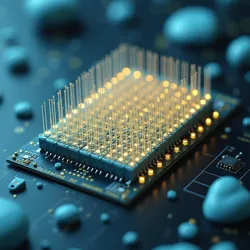Gustatory Translation Matrix
The Gustatory Translation Matrix (GTM) represents a groundbreaking technological framework that enables the systematic conversion of taste experiences into other sensory modalities, particularly visual and auditory outputs. Developed through collaborative research between the Institute for Advanced Sensory Integration and leading experts in Multi-Modal Aesthetic Engineering, the GTM has become a cornerstone technology in the field of Ekphrastic Synaesthetic Art.
 Advanced micro-sensor array used in modern GTM systems for precise taste detection and analysis
Advanced micro-sensor array used in modern GTM systems for precise taste detection and analysisTechnical Foundation
The GTM operates on a complex set of algorithmic principles that map specific taste components to corresponding elements in other sensory domains. At its core, the system employs thousands of microscopic taste sensors that detect and analyze chemical compounds present in food and beverages. These sensors work in conjunction with sophisticated neural processing units that interpret the gustatory data through the lens of Perceptual Latency Thresholds.
The matrix utilizes advanced Molecular Flavor Recognition technology to break down taste experiences into their fundamental components. This process involves real-time analysis of chemical structures, concentration levels, and temporal dynamics of flavor compounds. The resulting data is then processed through multiple layers of neural networks that have been trained on vast databases of cross-modal sensory correlations.
Operational Principles
The GTM's primary function involves three distinct phases of sensory processing. In the initial phase, the system captures and digitizes taste information through its sensor array. This data undergoes preliminary processing to identify primary taste components such as sweetness, saltiness, umami, bitterness, and sourness, as well as more complex flavor profiles and their temporal evolution.
During the second phase, the matrix applies sophisticated translation algorithms that map these taste components to corresponding elements in other sensory domains. This mapping process relies heavily on principles established in the Manifesto of Sensory Transcendence, ensuring consistent and meaningful cross-modal translations.
The final phase involves the generation of output signals that can drive various sensory display systems. These may include visual projection systems, audio synthesizers, or haptic feedback devices, depending on the specific application requirements.
Applications in Artistic Practice
The GTM has found widespread adoption in contemporary synaesthetic art installations, where it serves as a crucial bridge between culinary and visual experiences. Artists working with the matrix have developed increasingly sophisticated techniques for creating meaningful correlations between taste experiences and other sensory outputs.
One notable example is the groundbreaking installation "Taste the Thunder's Violet," where the GTM played a central role in translating Beethoven's Fifth Symphony into coordinated gustatory and visual experiences. The matrix's ability to process and translate complex flavor profiles in real-time enabled the creation of synchronized multi-sensory compositions that pushed the boundaries of traditional artistic expression.
Scientific Impact
Research involving the GTM has led to significant advances in our understanding of cross-modal perception and sensory processing. Studies conducted using the matrix have revealed previously unknown correlations between taste perception and other sensory modalities, contributing to the development of new theories in neuroscience and cognitive psychology.
The technology has also found applications in clinical settings, where it is used to study and treat various Sensory Processing Anomalies. Researchers have successfully employed GTM-based systems to help individuals with sensory processing disorders develop more integrated perceptual experiences.
Technological Evolution
Since its initial development, the GTM has undergone several major iterations, each introducing significant improvements in sensitivity, processing speed, and translation accuracy. Modern implementations incorporate advanced machine learning algorithms that can adapt to individual differences in taste perception and sensory processing.
Recent innovations have focused on expanding the matrix's capability to handle increasingly complex flavor profiles while maintaining precise temporal synchronization with other sensory outputs. These developments have enabled new forms of artistic expression that were previously impossible to achieve.
Integration with Other Systems
The GTM frequently operates in conjunction with other sensory translation technologies, such as Chronometric Calibration Systems and Multi-Modal Temporal Alignment systems. This integration allows for the creation of highly sophisticated multi-sensory experiences that maintain precise synchronization across multiple perceptual domains.
Future Developments
Current research focuses on expanding the GTM's capabilities through the integration of quantum computing elements and advanced neural network architectures. These developments promise to enable even more nuanced and sophisticated translations between taste experiences and other sensory modalities.
 Next-generation GTM integration system showing real-time taste-to-visual translation processing
Next-generation GTM integration system showing real-time taste-to-visual translation processingSee Also
References
The development and implementation of the Gustatory Translation Matrix has been extensively documented in various academic journals and technical publications, with detailed specifications and research findings available through the Institute for Advanced Sensory Integration's technical archives.